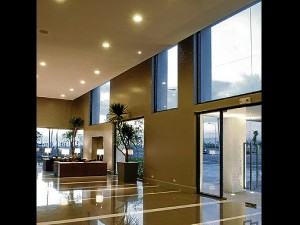Enjoying architecture from both inside and out

AN ARCHITECT’S expertise and understanding of space will manifest in the way exterior form and interior spaces are simultaneously molded: being inside can be as enjoyable an experience as looking at good architecture from a distance.
I’ve always enjoyed architecture. I say “enjoy” because it has always been a source of awe and wonder. I looked forward to seeing some of the beautiful homes and small buildings in the New Manila area near where I grew up. The styles fascinated me, and what I loved most were the polarity of the visuals: some homes in very modernist van der Rohe-like vertical and horizontal lines, and others, tiered heritage homes with post-colonial Spanish features.
To this day, I still watch over these buildings and hope that I would one day have the chance to enter them. Seeing them from a distance would probably pale in comparison to the experience of being within their bosom.
While I enjoy architecture and the exterior look of a building, I have to admit that interior spaces fascinate me more. Why? Because they are more human in scale. Being inside gives you more sensory experiences. Viewing architecture from the outside isn’t quite as multidimensional as viewing it from within, where the space encapsulates you, 360º, up and down. It’s like being within an alternate reality.
Underrated
Interior architecture is an underrated aspect of design. Most people view architecture as merely the design of the exterior, and see interior design merely as the decorative aspect, working on embellishment for enhancement. In reality, this is the common space where architecture and interior design overlap: the inside of a building as formed by its envelope, and the inside as carved from the interior designer’s understanding of how the spaces should work and feel from within.
Article continues after this advertisementIn coming up with the interior space, the primary responsibility truly lies with the architects, whose expertise and understanding of space will manifest in the way they simultaneously mold both the exterior form and the interior spaces. By space, I refer not only to the functional division of the various spaces, but rather, to the experience: the “feel” of the spaces, and the emotions they elicit from one who is within.
Article continues after this advertisementThe interior designer’s work is to enhance or fine tune. As such, bad interior architecture cannot be resolved even by the best interior designer. At most, it can be enhanced, albeit with a painful cost, and possibly with a lot of disrespect to the building’s true forms.
Great challenge
The great challenge for an architect is to work with scale in such a way that they can sculpt architecture to be appreciated from a distance, while at the same time imagine being within, so that it may cater to the smallest human function and experience.
Take for example a house with stunning architecture, which when entered, cannot accommodate the functional arrangements of the furnishings. I’ve seen many spaces like these: beautiful from the outside, but with odd nooks, disproportioned spaces, a lack of drama, and very bad furniture configuration with wall placements and floor space that will not allow for better ones. Sad. It is very artificial architecture: all style, no substance.
The best way to handle both architecture and interior design is to first select a good architect: one who has a clear understanding of both architecture and interior planning. Planning is crucial in the first stages of design, and correct assumptions—required hallway widths, sizes of furniture and other functional measurements—can make or break your spaces.
Your architect must look into the structure both from inside and out. Next, look for an interior designer with experience in interior architecture; someone who respects the concept of the architect, looks into the proper partitioning and allocation of spaces, determines appropriate ceiling heights, maximizes the usage of the building openings, and determines finishes that enhance the spaces.
Then, engage your interior designer at the early stages of the architecture, so that plans may be reviewed—and the interior spaces, validated—before they are finalized by the architect. If you have unfortunately engaged an architect who is not adept at planning interiors, this is a good time to do the improvements.
Lastly, consider an architect that can execute interior design. You will save time on the design phase, and you can save a substantial amount of money for any replanning or redesign. You are likelier to get better results: integrated planning and a powerful design concept. It is architecture you will enjoy from both inside and out.
Contact the author through [email protected] or through our Asuncion Berenguer Facebook account.